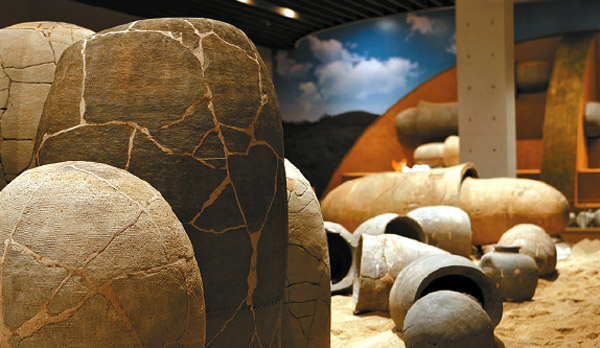Naju Museum offers a rare look into Mahan

Re-creations of earthen coffins that have been found in the Jeolla region. Such coffins were part of the burial culture of the Mahan confederacy, which existed from the first century B.C. to the third century. Provided by the museum
Nestled in Mount Jami in Naju, South Jeolla, amid the mysterious-looking ancient tombs from the Three Kingdoms era (57 B.C.-A.D. 668), and about a 20-minute drive from the downtown area, the two-story museum is hoping that visitors will love its natural setting and the quietness it has to offer.
“Our concept is slowness and healing,” Park Jung-hwan, the museum’s director, said. “We hope people would let go of their urban lives, where things move fast, and enjoy their time amid the ancient tombs, created about 1,500 years ago.”
The tombs that surround the museum, which is the country’s 13th national museum operated directly under the Ministry of Culture, Sports and Tourism, include some state-designated treasures: the Bannam Ancient Tombs of Naju (Korea’s Historic Site No. 513) and the Bogamni Ancient Tombs of Naju (Korea’s Historic Site No. 404).
The National Museum of Korea said the Naju Museum will specialize in the Mahan confederacy, a confederacy of statelets that existed from around the first century B.C. to the third century in the southern end of the Korean Peninsula, alongside the more famous Three Kingdoms of Goguryeo, Silla and Baekje.
At the opening exhibition, titled “Naju, 1,000-Year Moksagol,” some 1,500 relics will be on display. They include some of the museum’s star artifacts, like a glittering golden crown uncovered from one of the tombs in Sinchon-ni, which is National Treasure No. 295, as well as one of the documents about Japanese invasions, known as the Imjin War (1592-98), National Treasure No. 660.
One of the most notable features of this museum is that it will open its storage to the public. Through the glass, visitors can get a glimpse into the artifacts. Although it is seeking “slowness” and “healing,” the museum is also seeking to be high tech. By installing the near field communication (NFC) technology throughout its facilities, people can learn about the relics through their smartphones.
BY KIM HYUNG-EUN [hkim@joongang.co.kr]










with the Korea JoongAng Daily
To write comments, please log in to one of the accounts.
Standards Board Policy (0/250자)